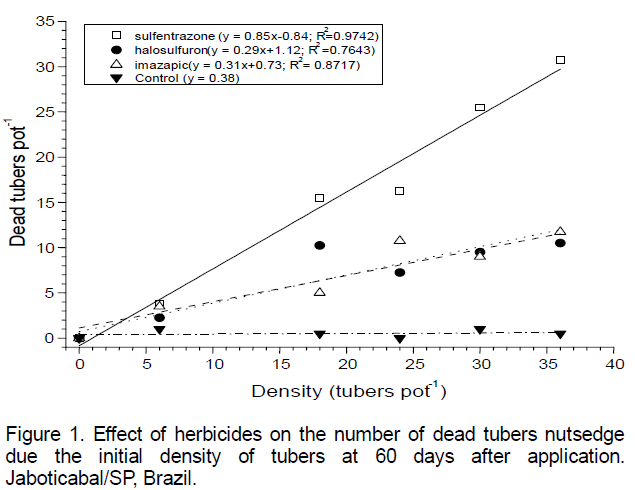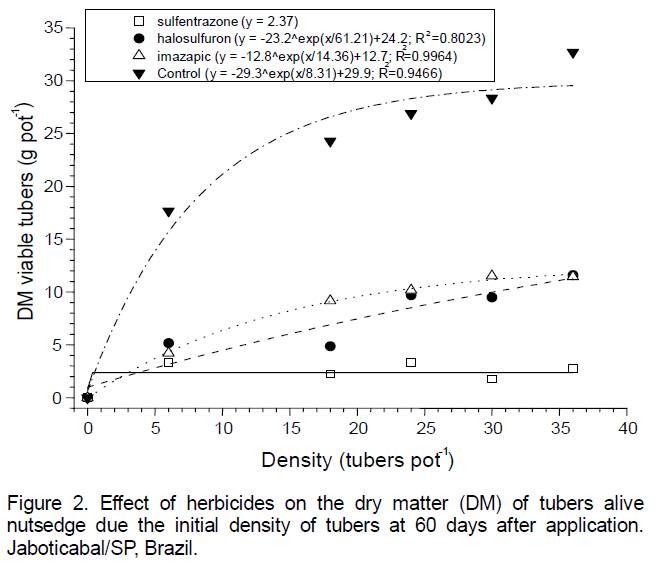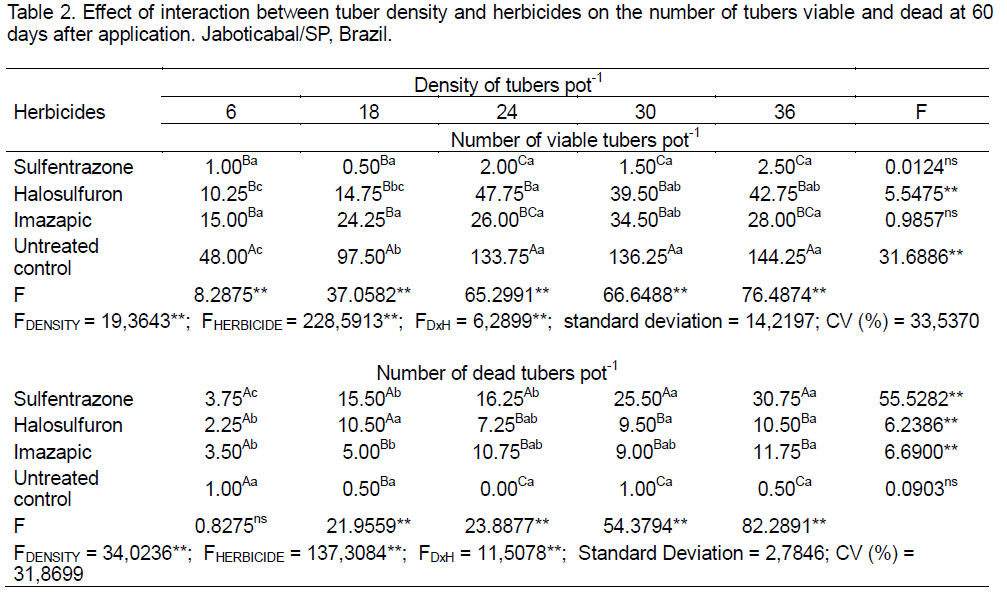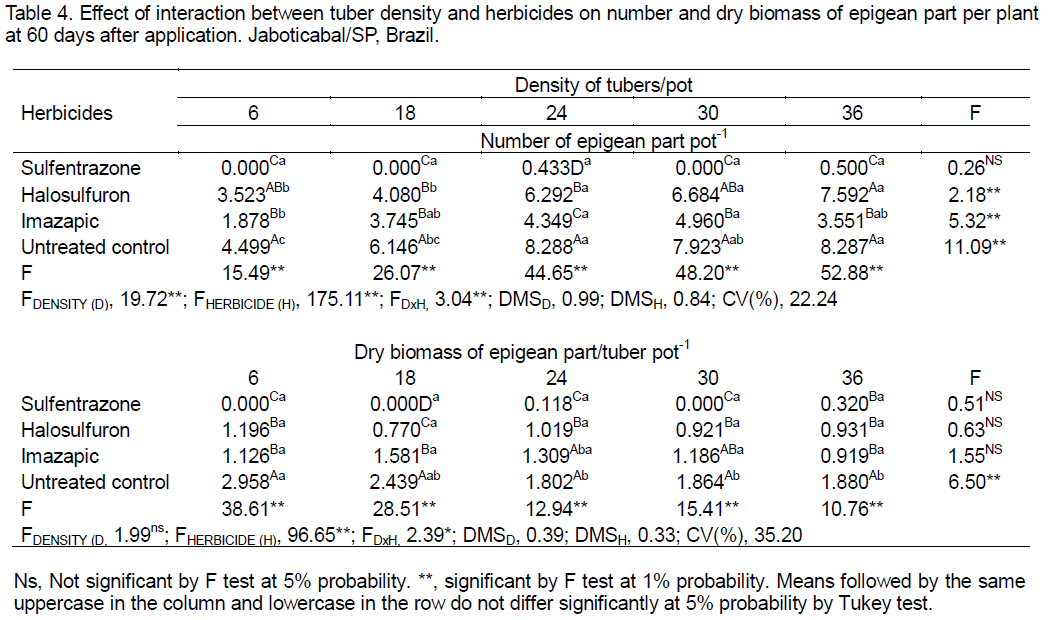Sugarcane is a crop that can be extremely affected by competition with weeds, often budding and exhibiting slow initial growth in response to this stress (Procópio et al., 2003). The weeds on sugarcane are responsible for up to 80% of production losses (Azania et al., 2008). Among the various weed species present in Brazilian sugarcane, Cyperus rotundus L. (nutsedge) is one of the most difficult to control, as few herbicides are recognized to provide effective control (Jakelaitis et al., 2003).
This weed grows mainly in the tropical and subtropical areas of the world (Brecke et al., 2005), resulting in significant losses in agricultural income (Bangarwa et al., 2008, Wang et al., 2008). Nutsedge is primarily characterized by its rapid growth rate (Lati et al., 2011) a single tuber can expand to an area of 5.5 m2, yielding 750 tubers within 24 weeks (Webster, 2005). The deleterious effect of this weed on sugarcane is a function of its underground structure; its underground weight is five to ten times greater than that of its shoots (Singh, 1968). Densities of nutsedge bulbs and tubers equal to or greater than 1.0 kg/m² cause a significant deleterious effect on the sprouting of some sugarcane varieties (Bacchi et al., 1984). Because of the plant’s ramified structure, efficient underground system and vegetative reproduction (bulbs, rhizomes and tubers), nutsedge can cause up to a 45% reduction in the production of sugarcane stalks when it occurs partially or entirely throughout the cycle of the crop (Keeley, 1987). Nutsedge competes for environmental resources (water, light and nutrients) (Durigan et al., 2005) and releases allelopathic compounds. Kuva et al. (2000) observed a 20% reduction in sugarcane productivity of sugarcane when the weed occurred throughout the crop cycle. Moreover, according to those authors, nutsedge control for only 22 days after sugarcane planting was enough to ensure that the crop reached 95% of its maximum productivity.
The mechanisms of tuber dormancy play an important role in weed dispersion (Nesser et al., 1997). Under satisfactory weather conditions, nutsedge tuber density in sugarcane can reach 3,000 tubers/m2, producing up to 2000 shoots/m2, which, after weeding, can grow from one to three centimeters per day (Lorenzi, 1983). A nutsedge tuber density of 815.5 tubers/m2 is commonly found in moderate infestations of sugarcane (Kuva et al., 2000).
Higher weed density in an area leads to a greater number of individuals competing for the same resources in the environment and, therefore, a stronger deleterious impact on the crop (Pitelli, 1985). Additionally, because the action of herbicides on the nutsedge tubers is directly related to their density, higher numbers of tubers in the soil mean that less herbicide is available for each tuber, which may hinder pre-emergence control.
Thus, as the control of weeds in sugarcane is essentially dependent on herbicide application, the present study evaluated the efficacy of sulfentrazone, halosulfuron and imazapic applied in pre-emergence conditions for the control of nutsedge (C. rotundus) in response to weed tuber density.
The experiment was conducted under partially controlled conditions (without water restriction) at experimental area located at 21°15'22'' south latitude, 48°18'58'' west longitude, and an altitude of 595 m. According to the global climate classification system of Köppen (1948), the climate is Cwa; the wet season is characterized by summer rains, and the winter is relatively dry.
For the experiment, 5 L pots were filled with soil collected from the surface soil of a red latosol, for which the chemical and physical characteristics are shown in Table 1. Based on the results of this chemical analysis, soil fertility was corrected prior to planting.
Nutsedge tubers were planted in the pots at densities of 6, 18, 24, 30 and 36 tubers/pot corresponding to 133.3, 399.9, 533.2, 665.5 and 799.8 tubers/m2, respectively; the maximum tuber density was similar to the density observed by KUVA et al. (2000) for weed tubers in sugarcane. The tubers were placed at a depth of 3 cm, and the pots were then watered and left untouched for 24 h before pre-emergence herbicide application. The doses used in this study followed those recommended for the control of C. rotundus in sugarcane: Sulfentrazone at 800 g a.i ha-1, halosulfuron at 112.5 g a.i ha-1 and imazapic at 147 g a.i ha-1. After herbicide application, the pots were watered as necessary.
Herbicide application was performed on wet soil using an XR 8002 backpack sprayer with 4 spouts under constant pressure (CO2), adjusted to a spraying consumption rate of 200 L ha-1. During the application, the temperature was 32.5°C, the RH was 47%, and the temperature of the soil (5 cm depth) was 36.8°C, with no wind or clouds.
A 5x4 factorial completely randomized design (CRD) was employed in this study, with 4 replications: the main factors were the 5 tuber densities and the 4 herbicide treatments, including the untreated control.
At the end of the experimental period (60 days after planting), the final number of epigean manifestations (shoots), dead tubers (rotten, blackened or voids) and viable tubers with the potential for reinfestation were evaluated. Tuber viability was assessed using the tetrazolium test. For the determination of dry weight, the shoots and viable tubers were cut, washed, bagged and placed to dry in an oven with forced air circulation at 70°C until they reached constant weight.
The data were submitted to analysis of variance using the F test, and the means were compared using Tukey’s test at 5% probability.
At the end of the experimental period, sulfentrazone decreased the total number of tubers per plant compared to the initial number of tubers regardless of density; the herbicide inhibited the multiplication of C. rotundus tubers from the beginning of the experiment. Average increases of 108, 40.8, 120.83, 63.33 and 47.92% for the initial tuber densities of 6, 18, 24, 30 and 36 tubers/pot, respectively, were observed in the halosulfron treatment. The average increases observed in the imazapic treatment for the initial tuber densities of 6, 18, 24, 30 and 36 tubers/pot were 208.33, 62.50, 53.13, 45.00 and 10.42%, respectively. For the untreated control, the increases were considerably higher than those observed for the herbicide treatments: 716.67, 444.44, 457.20, 357.50 and 302.08% for the respective increasing densities (data not shown). The low rates of tuber multiplication observed at higher densities should not be attributed solely to the initial action of the herbicides imazapic and halosulfuron. At a density of 6 tubers/pot, where the availability of the herbicide to each tuber was higher, the rate of tuber multiplication was higher compared to that of the other densities. The same behavior was observed in the control treatment. Thus, in the treatments with the highest number of tubers per area, intraspecific competition occurred for environmental resources (water and space), which caused a reduction in the rate of tuber multiplication.
The application of a pre-emergence herbicide for the control of nutsedge is expected that to quickly reduce tubers or even prevent the multiplication of nutsedge in the soil, preventing reinfestation. The reduction in tuber multiplication rate is related to the efficacy of the herbicide in promoting the death of the tubers. Under the conditions of this study, the herbicide sulfentrazone increased the number of dead tubers linearly with increasing initial density of tubers, at a rate of 0.85 dead tubers per tuber planted, whereas with imazapic and halosulfuron, this increase in mortality was only 0.30. For the untreated control, the mortality of tubers was 0.38 for all densities (Figure 1).

The number of viable tubers decreased exponentially with increasing initial density of tubers; this effect was greatest for halosulfuron (61.21), followed by imazapic (14.36) and the untreated control (8.31). For sulfentrazone, the number of viable tubers was the same (2.37) for all densities and substantially lower than the values ??of the other treatments (Figure 2).

No significant differences in the herbicide effects on the number of viable tubers were observed at densities of 6 and 18 tubers/plant. Overall, sulfentrazone was superior to the other herbicides in decreasing the number of viable tubers. In general, imazapic and halosulfuron yielded statistically similar effects regarding the number of viable tubers. However, all herbicide treatments differed from the control for this parameter. Similarly, regarding tuber mortality, sulfentrazone achieved a control rate ranging from 79 to 97% among the different densities. The herbicides halosulfuron and imazapic also promoted the mortality of tubers, with average values ranging from 13 to 41% for halosulfuron and from 18 to 43% for imazapic. For the untreated control, the mortality rate of tubers did not exceed 2%, indicating that all the herbicides had an effect on the control of tubers. For this parameter, the density was significant for the effect of the herbicide at a density of 6 tubers/plant. However, a direct relationship between the interaction of density and herbicide on tuber mortality could not be obtained (Table 2).

The dry weight of those tubers that remained viable or capable of promoting multiplication and reinfestation was reduced in all herbicide treatments compared to the untreated control at all densities. At a density of 6 tubers/pot, the results of the sulfentrazone, imazapic and halosulfuron treatments were similar. At a density of 18 tubers/pot, the biomass of viable tubers in the halosulfuron treatment was similar to that in the sulfentrazone and imazapic treatments, with sulfentrazone yielding a lower biomass of viable tubers than imazapic. For other densities (24, 30 and 36 tubers/pot), sulfentrazone also promoted a lower biomass of viable tubers than did halosulfuron and imazapic, which yielded similar results (Table 3).
Ns, Not significant by F test at 5% probability. **, significant by F test at 1% probability. Means followed by the same uppercase in the column and lowercase in the row do not differ significantly at 5% probability by Tukey test.
As the control of tuber production and sprouting is the most important effect of an herbicide used to manage this weed for a longer period of time (Durigan et al., 1991), sulfentrazone proved to be more effective than the other herbicides. Other authors have also obtained excellent results for nutsedge control using sulfentrazone (Langbeck et al., 2004). The efficacy of sulfentrazone for the control this species has been evaluated in several studies and its suppressor potential has been highlighted by Wehtje et al. (1997), Werlang et al. (2004) and Rahnavard et al. (2010).
Treatment with sulfentrazone also promoted fewer epigean manifestations (Table 4) compared to the other treatments: At densities of 6, 18 and 30 tubers/pot, the sprouting of tubers was completely inhibited by sulfentrazone. At densities of 6, 30 and 36 tubers/pot, halosulfron did not promote the efficient control of the epigean manifestations, presenting results similar to those of the untreated control (no herbicide). At all densities, the imazapic treatment caused a reduction in sprouting tubers compared to the control but was less effective than sulfentrazone. At densities of 6 and 30 tubers/pot, the imazapic and halosulfuron treatments were similar to the untreated control in their effects on the sprouting of nutsedge tubers. The number of epigean manifestations per area is closely related to the production of rhizomes and tubers (Williams, 1978) and, consequently, to the competitive abilities of the plant. A greater number of epigean manifestations leads to a greater rate of weed multiplication and spread over an area. If a herbicide does not promote tuber inviability, the chemical control of nutsedge will not be effective.

For the dry biomass of epigean manifestations (Table 3), the three herbicide treatments yielded results that differed statistically from those of the untreated control regardless of density, except for imazapic at a density of 30 tubers/pot; these results demonstrated significant effects of the herbicides on this characteristic at the evaluated densities. Except for the density of 36 tubers/pot, at which no significant differences were observed among the herbicides, sulfentrazone achieved lower values for the dry biomass of epigean manifestations than those obtained by imazapic, halosulfuron and the untreated control, demonstrating its high potential for the control of nutsedge. At densities of 18 and 24 tubers/pot, significant differences were observed between halosulfuron and imazapic, with halosulfuron achieving better control of tuber sprouting. When a tuber remains viable in the soil, it uses its energy reserves to issue new epigean manifestations under favorable environmental conditions. Durigan et al. (2005) evaluated the effects of nutsedge density (Cyperus rotundus L.) on its chemical control in sugarcane, observing that the herbicides sulfentrazone and imazapic, when applied pre-emergence, provided control levels of 79.6 and 70 6%, respectively. In another study, Durigan et al. (2004) studied the control of nutsedge (Cyperus rotundus L.), observing that in the absence of straw, the herbicides sulfentrazone and imazapic achieved a control level of over 80% within 90 days.
However, in the present work, imazapic was not as effective as sulfentrazone. This result may be explained by the acidity of imazapic (pKa = 3.9), resulting in the lower sorption of the herbicide and a higher potential for leaching to lower soil layers, a phenomenon previously observed by Monquero et al. (2010).
Another important factor that may have contributed to the leaching of the herbicide is soil texture, which facilitates the percolation of water in the profile, allowing the greater downward movement of herbicide by mass flow. Sandy soils exhibit greater leaching of herbicide than do silt or clay soils (Rossi et al., 2005). Thus, the leaching of imazapic likely affected the activity of the herbicide and thereby reduced its potential for tuber control at the evaluated densities.
The same reasoning also applies for halosulfuron, which has a pKa of 3.5 and consequently may have also leached into the soil profile. Halosulfuron is recommended for the postemergence control of weeds, as 1 to 20% of the herbicide is absorbed by leaves while only 0.1 to 5% is taken up by the root system (Mascarenhas et al., 1995). However, even when the herbicide is applied preemergence, as in this work, its control potential is equal to that of imazapic, especially at higher tuber densities.
Conversely, sulfentrazone has a low dissociation in water and behaves as a weak acid (pKa = 6.56), existing in the soil solution primarily in its nonionized form (FMC, 1995). Rossi et al. (2005) evaluated the mobility of sulfentrazone in Red Latossol in terms of rainfall, characterizing sulfentrazone as very mobile, remaining on the soil surface regardless of the rainfall measured. This reported low mobility of the herbicide corroborates the observations of Alves et al. (2004), who reported that the mobility and adsorption capacity of sulfentrazone in the soil is heightened when the soil pH is below the pKa of the herbicide; this situation reduces the efficiency of the herbicide in the field. In this study, the pH of the soil solution and the pKa of the herbicide were similar. As the nutsedge tubers in this study were placed at a depth of 3 cm beneath the soil surface, this observation explains the superiority of the control promoted by this herbicide at all tuber densities over that of halosufuron and imazapic.
In summary, under the conditions of this study, treatment with sulfentrazone caused a greater mortality rate of C. rotundus tubers and greater consequent reductions in the numbers of viable tubers and epigean manifestations than did treatment with halosulfuron or imazapic, demonstrating that this herbicide was more effective for the pre-emergence control of the weed. Importantly, this herbicide inhibited the multiplication rate of the tubers from the point of its application. In general, treatments with lower tuber density showed a higher mortality rate of tubers and, consequently, a lower number of viable tubers, confirming the hypothesis that the availability of the herbicide for each reproductive structure is increased at low densities. To optimize the control of C. rotundus, further studies should evaluate dose adjustments of halosulfuron and imazapic for application on sandy soils, especially in areas with a history of high infestation of this weed.